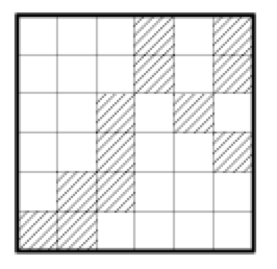Problems
A pedestrian walked along six streets of one city, passing each street exactly twice, but could not get around them, having passed each one only once. Could this be?
Cut the board shown in the figure into four congruent parts so that
each of them contains three shaded cells. Where the shaded cells are
placed in each part need not be the same.

a) In how many ways can Dima paint five Christmas trees in silver, green and blue colours, if the amount of paint is unlimited, and he paints each tree in only one colour?
b) Dima has five baubles: a red, a green, a yellow, a blue and a gold one. In how many ways can he decorate five Christmas trees with them, if he needs to put exactly one bauble on each tree?
c) What about if he can hang several baubles on one Christmas tree (and all of the baubles have to be used)?
In a chess tournament, each participant played two games with each of the other participants: one with white pieces, the other with black. At the end of the tournament, it turned out that all of the participants scored the same number of points (1 point for a victory, \(\frac{1}{2}\) a point for a draw and 0 points for a loss). Prove that there are two participants who have won the same number of games using white pieces.
A teacher filled the squares of a chequered table with \(5\times5\) different integers and gave one copy of it to Janine and one to Zahara. Janine selects the largest number in the table, then she deletes the row and column containing this number, and then she selects the largest number of the remaining integers, then she deletes the row and column containing this number, etc. Zahara performs similar operations, each time choosing the smallest numbers. Can the teacher fill up the table in such a way that the sum of the five numbers chosen by Zahara is greater than the sum of the five numbers chosen by Janine?
Eight schoolchildren solved \(8\) tasks. It turned out that \(5\) schoolchildren solved each problem. Prove that there are two schoolchildren, who solved every problem at least once.
If each problem is solved by \(4\) pupils, prove that it is not necessary to have two schoolchildren who would solve each problem.
Some squares on a chess board contain a chess piece. It is known that each row contains at least one chess piece, but that different rows all have different numbers of pieces. Prove that it is always possible to mark 8 pieces so that each row and each column of the board contains exactly one marked piece.
Sarah believes that two watermelons are heavier than three melons, Anna believes that three watermelons are heavier than four melons. It is known that one of the girls is right, and the other is mistaken. Is it true that 12 watermelons are heavier than 18 melons? (It is believed that all watermelons weigh the same and all melons weigh the same.)
What is the largest number of counters that can be put on the cells of a chessboard so that on each horizontal, vertical and diagonal (not only on the main ones) there is an even number of counters?
Is it possible to arrange natural numbers from 1 to \(2002^2\) in the cells of a \(2002\times2002\) table so that for each cell of this table one could choose a triplet of numbers, from a row or column, where one of the numbers is equal to the product of the other two?